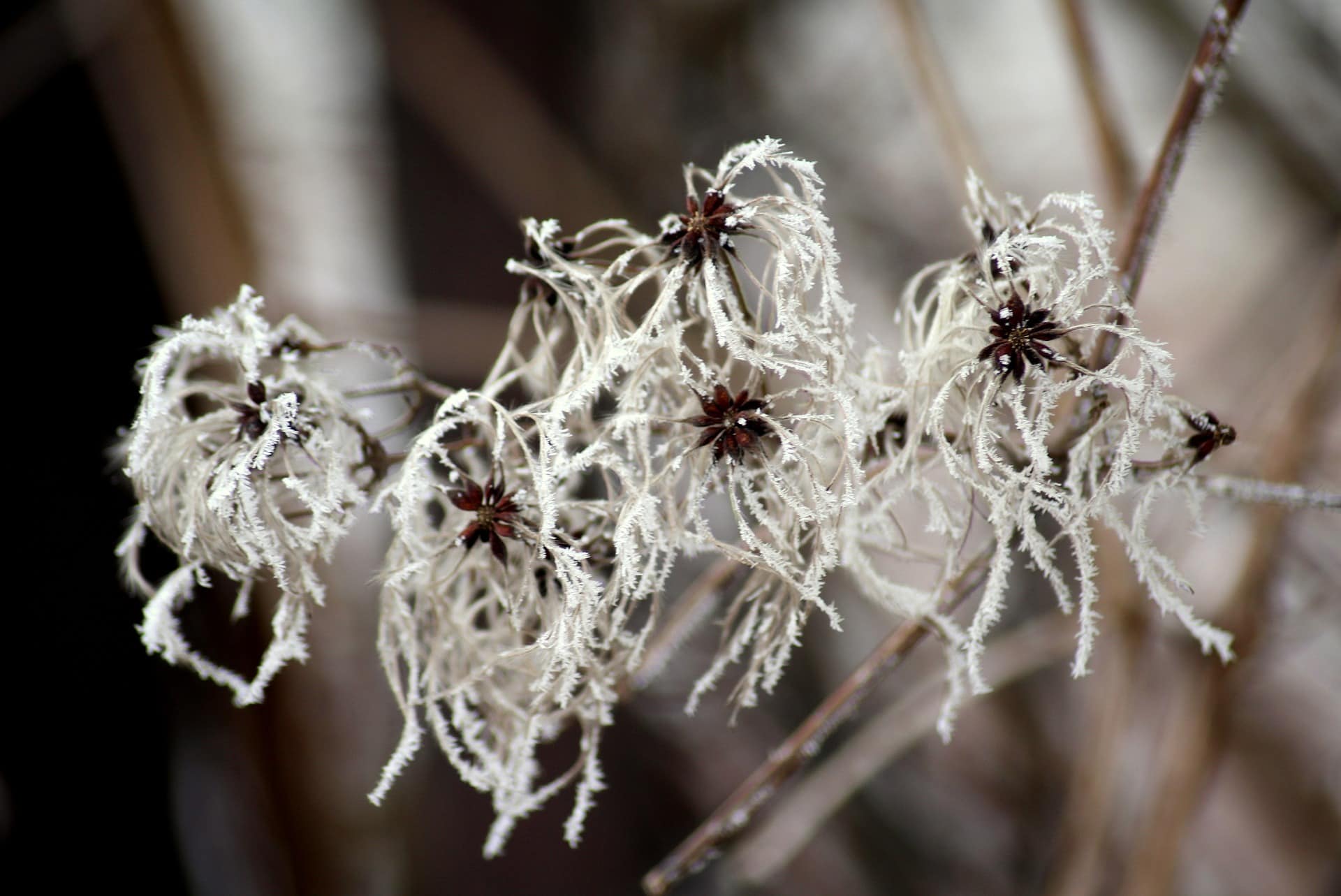Clematis do need a little bit of care and preparation to overwinter successfully. Clematis are perennial plants and they usually are dormant during the winter, during this time they will look like they are dead, this is normal, so no need to worry about it.
To care for clematis in the winter make sure to prune them in the fall. Before the first frost comes, apply a generous amount of mulch around the stem of the plants, this will keep the roots moist and warm during the winter. If you are overwintering your Clematis in pots, then make sure to water them from time to time, if not, the entire plant will dry out and die.
If you are worried that your Clematis might not survive the winter, then my personal recommendation is to use a plant cover that protects them from frost and is made out of cloth Click here to check it out on Amazon.com
During the winter, when the soil is frozen, the Clematis will still survive, what actually can kill them is the process of freezing and thawing. What usually tends to kill most Clematis during the winter is drying out, this is especially true for Clematis that are overwintering in pots. Dry winters or windy ones will dry out the topsoil, which usually means that the roots of the plants also dry out, and eventually the entire plant will die.
Clematis can overwinter both in pots and in the ground as well, but make sure that they still get enough water during the winter. If your clematis is on its last leg, then check out my recent article How To Revive A Clematis ( In 6 Steps ).
Clematis Winter Care
In late fall, after the foliage has died back, it’s important to prune your clematis. Cut back the stems to about 6 to 12 inches above the ground, removing any dead or damaged growth. This helps prevent disease and encourages healthy regrowth in the spring. Once pruned, provide a layer of mulch around the base of the plant to insulate the roots and protect them from freezing temperatures. You can use materials like straw, compost, or shredded leaves.
It’s also advisable to provide some form of winter protection, such as a burlap cover or a frost blanket, especially for young or newly planted clematis. This will shield the plant from freezing winds and extreme temperature fluctuations. Regularly check the moisture levels during winter, ensuring the soil doesn’t become overly dry.
Earn a 50% Commission on each sale by simply sharing my guides with friends and family on social media, check out Flower Duty Affiliates
Prune The Clematis In The Fall
Your first step of winter care for the Clematis will be pruning, just keep in mind that not all Clematis are pruned the same. Make sure to know to which group your Clematis belongs and prune it accordingly. Some Clematis can be pruned right back to the ground, these are the ones that flower on new wood, and others have to be pruned relatively lightly because they flower on old wood.
If you do not prune the Clematis correctly then the plant might not flower the next season. Pruning is very important before the winter, some of the Clematis stems will die off and form small cracks where water will collect. This excess water will freeze and expand, which eventually might damage the healthy parts of the stem as well. By pruning the Clematis you will actually make it bushier, for more information check out my recent article How To Make Clematis Bushier? ( In 7 Easy Steps ).
Mulching The Clematis For The Winter
Now that you have pruned your Clematis, you should protect it with a thick layer of mulch. Mulches will keep the soil moist, just like the Clematis loves it, and it will also protect the roots from the cold. Mulching the Clematis is especially important if you live in an area where the winters are relatively dry, as these plants are prone to drying out. For Clematis you can use grass clippings, wood chips, hay, straw, animal manure, and leaves as mulch.
These mulches, except the wood chips, will break down in a matter of months, and the nutrients will be used by the Clematis. The one thing to keep in mind with organic mulches is that they attract a lot of slugs and snails, which will eat the Clematis sprouts in the spring. So if your garden has a lot of slugs and snails, then just use wood chips as mulch, or start sprinkling slug pellets when spring comes.
Use A Plastic Bottle To Protect The Clematis In The Winter
Young Clematis that are just a couple of inches long, will survive the winter, although they tend to be a lot more sensitive than established plants. If your clematis is only a couple of inches tall, then take a plastic bottle, cut the bottom off, and place it on the plant. Make sure to remove the bottle cap as well, after you have placed the plastic bottle on the plant you will notice water droplets on the inside of the bottle.
The plastic bottle will have two functions, protect the Clematis from the outside elements and trap moisture inside, this is especially useful for areas with really dry winters. You can use plastic covers for larger Clematis, I highly recommend them if your Clematis always seem to wake up way too late in the spring.
Watering The Clematis In The Winter
Clematis will need to be watered in the winter, or else they will simply dry out. Way too many people skip this part of overwintering the Clematis only to end up with the plant partially or completely drying out. If you are growing the Clematis directly in the soil, then you do not have to water them during the winter. With that being said, if you notice that the soil is drying out, then water the Clematis even in the middle of the winter.
Clematis that are overwintered in pots are more prone to drying out, because most people just place the pots in a random corner of the garden, or even worse in a sheltered area where snow and rain don’t reach them. In this case, you should water the Clematis during the winter once every week, although a much more effective solution would be just to place the pot in an area where rain and snow can drop on it.
Overwintering Clematis Indoors
You can actually overwinter the Clematis indoors, although it is not really necessary. As Clematis are perennials they do have a dormancy period which is usually kickstarted by cold weather. If you take the Clematis indoors, before the first frost, or if you are growing the Clematis indoors all year round then they will not go dormant. Although they will not go dormant some changes will still occur, usually in the form of losing leaves.
If you want to overwinter the Clematis indoors then make sure to prune it, it will lose most of its leaves as the days become shorter. The Clematis will grow new leaves even in the middle of the winter if it is indoors, although the plant might get leggy because it doesn’t get enough sunlight. If you want to know how to deadhead clematis then check out my recent article How To Deadhead Clematis ( In 4 Easy Steps).
Key Takeaways
- Clematis winter care includes pruning, mulching, and making sure that the Clematis gets enough water during the winter.
- Clematis can overwinter both in pots and in the ground as well
- Make sure that you prune the Clematis according to which group it belongs.

